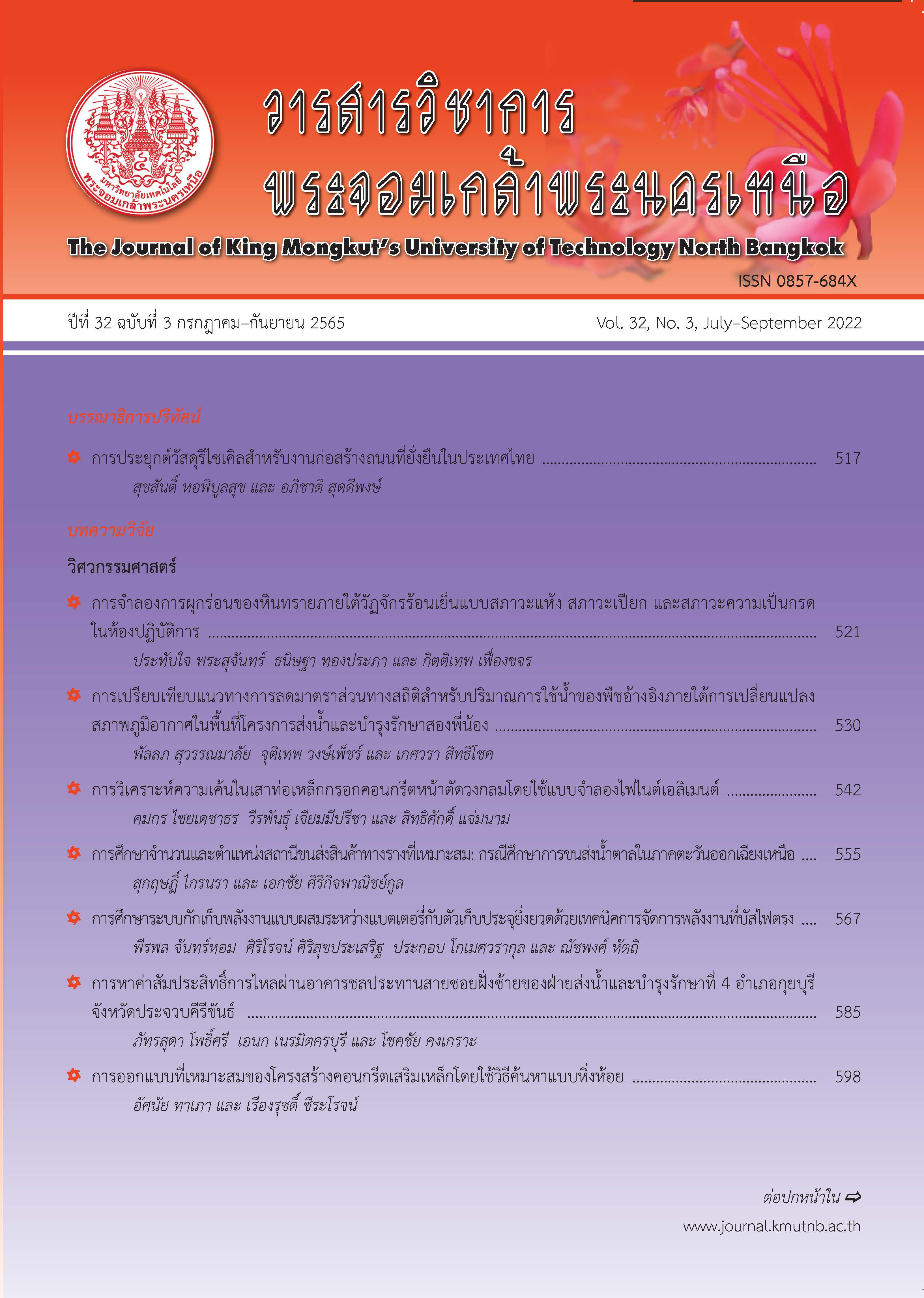การจำลองการผุกร่อนของหินทรายภายใต้วัฏจักรร้อนเย็นแบบสภาวะแห้ง สภาวะเปียกและสภาวะความเป็นกรดในห้องปฏิบัติการ
Main Article Content
บทคัดย่อ
การจำลองการผุกร่อนของหินทรายได้นำตัวอย่างหินทรายจำนวน 4 ชนิดมาทดสอบภายใต้วัฏจักรร้อน-เย็น เป็นจำนวน 300 วัฏจักร โดยนำตัวอย่างหินทรายแต่ละชนิดมาทำการทดสอบสภาวะการเย็นตัว 3 แบบ ได้แก่ การปล่อยให้เย็นที่อุณหภูมิห้อง การจุ่มลงในน้ำกลั่น และการจุ่มลงในกรดซัลฟิวริก (มีค่าความเป็นกรดเท่ากับ 5.6) ผลที่ได้ระบุว่าหินทรายทุกชนิดไม่อ่อนไหวต่อสภาวะร้อน-เย็นแบบแห้ง อย่างไรก็ตาม หินทรายเหล่านี้อ่อนไหวอย่างมากต่อน้ำและกรด การทำให้ตัวอย่างหินลดอุณหภูมิลงโดยฉับพลันในของเหลวอาจเป็นสาเหตุทำให้เกิดรอยแตกขนาดเล็กในวัสดุเชื่อมประสานของหิน ซึ่งต่อมาทำหน้าที่เป็นช่องเปิดให้ของเหลวซึมลึกลงไปในตัวอย่างหิน เมื่อวัสดุเชื่อมประสานของหินทรายถูกละลายด้วยของเหลว ส่งผลให้ความหนาแน่น กำลังรับแรงสูงสุดและโมดูลัสความยืดหยุ่นของหินทรายมีค่าลดลงเมื่อจำนวนรอบของวัฏจักรการจำลองเพิ่มขึ้น ผลที่ได้จากการศึกษานี้เป็นประโยชน์ในการคัดสรรและการนำหินทรายไปประยุกต์ใช้ในอุตสาหกรรมหินก่อสร้างและหินประดับ
Article Details

อนุญาตภายใต้เงื่อนไข Creative Commons Attribution-NonCommercial-NoDerivatives 4.0 International License.
บทความที่ลงตีพิมพ์เป็นข้อคิดเห็นของผู้เขียนเท่านั้น
ผู้เขียนจะต้องเป็นผู้รับผิดชอบต่อผลทางกฎหมายใดๆ ที่อาจเกิดขึ้นจากบทความนั้น
เอกสารอ้างอิง
Q. Sun and Y. Zhang, “Combined effects of salt, cyclic wetting and drying cycles on the physical and mechanical properties of sandstone,” Engineering Geology, vol. 248, pp. 70–79, 2019.
Z. Zhou, X. Cai, L. Chen, W. Cao, and Y. Zhao, “Influence of cyclic wetting and drying on physical and dynamic compressive properties of sandstone,” Engineering Geology, vol. 220, pp. 1–12, 2017.
G. Pardini, G. V. Guidi, R. Pini, D. Regüés, and F. Gallart, “Structure and porosity of smectitic mudrocks as affected by experimental wettingdrying cycles and freezing-thawing cycles,” Catena, vol. 27, no. 3–4, pp. 149–165, 1996.
P. D. Sumner and M. J. Loubser, “Experimental sandstone weathering using different wetting and drying moisture amplitudes,” Earth Surface Processes and Landforms: Journal of the British Geomorphological Research Group, vol. 33, no. 6, pp. 985–990, 2008.
A. Özbek, “Investigation of the effects of wetting-drying and freezing-thawing cycles on some physical and mechanical properties of selected ignimbrites,” Bulletin of Engineering Geology and the Environment, vol. 73, no. 2, pp. 595–609, 2014.
G. Khanlari and Y. Abdilor, “Influence of wetdry, freeze-thaw, and heat-cool cycles on the physical and mechanical properties of Upper Red sandstones in central Iran,” Bulletin of Engineering Geology and the Environment, vol. 74, no. 4, pp. 1287–1300, 2015.
H. F. Deng, J. L. Li, M. Zhu, K. W. Wang, L. H. Wang, and C. J. Deng, “Experimental research on strength deterioration rules of sandstone under “saturation-air dry” circulation function,” Rock and Soil Mechanics, vol. 33, no. 11, pp. 3306–3312, 2012.
P. A. Hale and A. Shakoor, “A laboratory investigation of the effects of cyclic heating and cooling, wetting and drying, and freezing and thawing on the compressive strength of selected sandstones,” Environmental and Engineering Geoscience, vol. 9, no. 2, pp. 117–130, 2003.
Z. Zhao, J. Yang, D. Zhang, and H. Peng, “Effects of wetting and cyclic wetting–drying on tensile strength of sandstone with a low clay mineral content,” Rock Mechanics and Rock Engineering, vol. 50, no. 2, pp. 485–491, 2017.
S. Lee, “The third periodic report on the state of acid deposition in east Asia, part II national assessments,” presented at the Acid Deposition Monitoring Network in East Asia, Niigata-shi, Japan, 2016.
Standard Test Method for Relative Density (Specific Gravity) and Absorption of Coarse Aggregate, ASTM C127-15, 2015.
Standard Test Method for Flexural Strength of Concrete (Using Simple Beam With Center-Point Loading), ASTM C293 / C293M-16, 2016.
Standard Test Methods for Compressive Strength and Elastic Moduli of Intact Rock Core Specimens under Varying States of Stress and Temperatures, ASTM D7012-14e1, 2014.
A. Racey, M. A. Love, A. C. Canham, J. G. S. Goodall, S. Polachan, and P. D. Jones, “Stratigraphy and reservoir potential of the Mesozoic Khorat Group, NE Thailand: Part 1: Stratigraphy and sedimentary evolution,” Journal of Petroleum Geology, vol. 19, no. 1, pp. 5–39, 1996.

